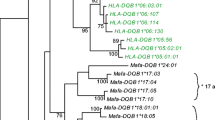Abstract
The cross-reactivity of several monoclonal antibodies recognizing monomorphic determinants of human HLA-A, B, C, and DR antigens and human β2-microglobulin (β2m) has been studied on peripheral blood leukocytes in 24 different species. An monoclonal HLA-A-, B-, and C-specific antibody and four monoclonal HLA-DR-specific antibodies cross-reacted with cells from all the primate species tested. Furthermore, antibodies HLA-DR-specific were positive with peripheral blood leukocytes (PBL) from cows, goats, sheep, horses, and dogs. Two monoclonal β2m-specific antibodies, which were positive with PBL from certain primates, also reacted with cells from cows, goats, sheep, horses, and dogs. Two other #2m-specific antibodies reacted only with PBL from chimpanzees. No reaction could be detected with all our reagents in other classes tested (birds, reptiles, amphibians, and Teleostei).
Similar content being viewed by others
References
Armerding, D., Sachs, D. H., and Katz, D. H.: Activation of T and B lymphocytes in vitro. III. Presence of la determinants on allogeneic effect factor. J. Exp. Med. 140: 1717–1722, 1974
Balner, H., van Leeuwen, A., Van Vreeswiik, W., Dersjant, H., and van Rood, J. J.: Leukocyte antigens of rhesus monkeys (Rh L-A) and chimpanzee (Ch L-A): similarities with the human HL-A system. Tissue Antigens 1: 229–238, 1971
Brodsky, F. M., Bodmer, W. F., and Parham, P.: Characterization of a monoclonal anti-β2-microglobulin antibody and its use in the genetic and biochemical analysis of major histocompatibility antigens. Eur. J. Immunol. 9: 536–545, 1979
Colombani, J., Colombani, M., Degos, L., David, C. J., and Shreffler, D. C.: Reactivity of anti-HLA sera against mouse lymphocytes. Tissue Antigens 9: 111–120, 1977
Dorf, M. E., Toth, E. K., and Balner, H.: Cross-reaction of HL-A antibodies: V-Relationship between the human HL-A11 and chimpanzee ChW-11 specificities. Tissue Antigens 2: 461–472, 1972
Fridman, W. H., Rabourdin-Combe, C., Neauport-Sautes, C., and Gisler, R. H.: Characterization and function of T-cell Fcγ receptor. Immunol. Rev. 56: 51–88, 1981
Gates, F. T., Coligan, J. E., and Kindt, T. J.: Complete amino-acid sequences of rabbit β2-microglobulin. Biochemistry 18: 2267–2272, 1979
Gordon, S. M. and Kindt, T. J.: Detection of β2-microglobulin in sera from diverse vertebrate species by the use of a heterologous radioimmunoassay. Scand. J. Immunol. 5: 505–511, 1976
Kapp, J. A.: Immunosuppressive factor(s) extracted from lymphoid cells of non-responder mice primed with L-glutamic acid 60-L-alanine-L-tyrosine10 (GAT). IV. Lack of strain restriction among allogeneic non-responder donors and recipients. J. Exp. Med. 147: 997–1006, 1978
Lipinsky, M. Fridman, W. H., Tursz, T., Vincent, C., Pious, D., and Fellous, M.: Absence of allogeneic restriction in human T cell mediated cytotoxicity to Epstein-Barr virus-infected target cells. Demonstration of an HLA-linked control at the effector level. J. Exp. Med. 150: 1310–1322, 1979
McMichael, A. J., Parham, P., Brodsky, F. M., and Pilch, J. R.: Influenza virus-specific cytotoxic T lymphocytes recognize HLA-molecules. Blocking by monoclonal anti-HLA antibodies. J. Exp. Med. 152: 195s-203s, 1980
Michaelson, J., Rothenberg, E., and Boyse, E. A.: Genetic polymorphism of murine β2-microglobulin detected biochemically. Immunogenetics 11: 93–95, 1980
Parham, P., Sehgal, P. K., and Brodsky, F. M.: Anti-HLA-A, B, C monoclonal antibodies with no alloamigenic specificity in human define polymorphisms in other primate species. Nature 279: 63–641, 1979
Rabourdin-Combe, C., Dorf, M. E., Guimezanes, A., and Fridman, W. H.: T-cell produced immunoglobulin binding factor (IBF) bears determinants coded for by the I region of the major histocompatibility complex and lacks allogeneic restriction. Ear. J. Immunol. 9: 237–242, 1979
Waltenbaugh, C., Debré, P., Theze, J., and Benacerraf, B.: Immuno-suppressive factor(s) specific for L-glutamic acid 50-L-tyrosine50 (GT). I. Production, characterization, and lack of H-2 restriction for activity in recipient strains. J. Immunol. 118: 2073–2077, 1977
Author information
Authors and Affiliations
Rights and permissions
About this article
Cite this article
Teillaud, JL., Crevat, D., Chardon, P. et al. Monoclonal antibodies as a tool for phylogenetic studies of major histocompatibility antigens and β 2-microglobulin. Immunogenetics 15, 377–384 (1982). https://doi.org/10.1007/BF00364261
Received:
Revised:
Issue Date:
DOI: https://doi.org/10.1007/BF00364261




